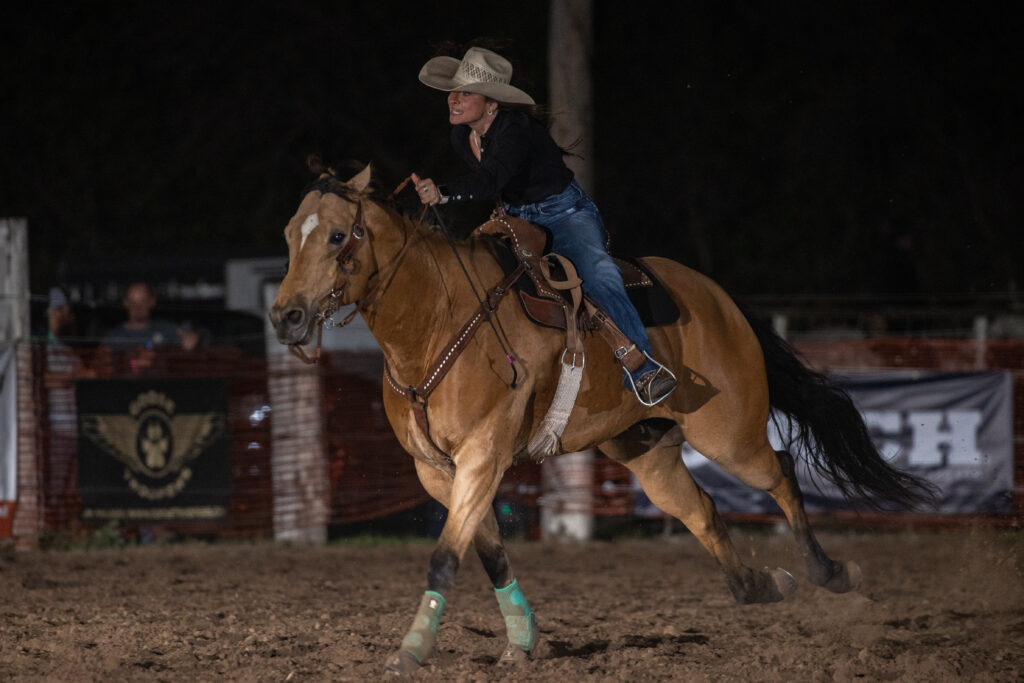Barrel racing is a demanding sport that requires the coordinated effort of various muscle groups in a horse’s body, and when one is out of whack, others are in danger, too.
Here’s seven main muscle groups horses use in barrel racing and why they matter.
Gluteal Muscles
The gluteal muscles, including the gluteus maximus, medius, and minimus, are located in the horse’s hindquarters. These muscles are responsible for generating power and propulsion during acceleration and turning around the barrels.

Quadriceps
The quadriceps, a group of muscles located on the front of the horse’s thighs, are crucial for extending the horse’s legs during galloping and driving forward momentum. They play a significant role in powering through tight turns.

Hamstrings

The hamstrings, located on the back of the horse’s thighs, are responsible for flexing the horse’s hind legs and providing stability during turns. These muscles aid in deceleration and controlling speed.
Abdominal muscles
The abdominal muscles, including the rectus abdominis and obliques, help stabilize the horse’s core and maintain balance while navigating tight turns. They assist in maintaining proper body alignment and preventing excessive leaning or collapsing.

Back muscles
The muscles along the horse’s back, including the longissimus dorsi and iliocostalis, provide stability and support during the dynamic movements required in barrel racing. They aid in maintaining balance and absorbing shock.

Shoulder muscles
The shoulder muscles, such as the deltoids and trapezius, are involved in the horse’s forelimb movement, which is essential for maneuvering around the barrels with agility. These muscles assist in lifting and reaching forward during turns.
Neck Muscles
The neck muscles, including the trapezius and brachiocephalicus, play a role in balancing and flexing the horse’s neck during turns. They contribute to the horse’s ability to position its head and neck for optimal balance and control.

How to take care of your horse’s muscles
It’s important to note that barrel racing engages multiple muscle groups throughout the horse’s body, working in harmony to execute precise movements and quick turns. Conditioning and strengthening these muscles through targeted exercise programs can enhance a horse’s performance and minimize the risk of injuries.
Spare proper conditioning, two easy ways to ensure that your horse’s muscles are feeling great are using a feed-through supplement daily and a topical treatment after workouts. Utilizing both can help horses get the muscular support they need from the cellular level, plus help with recovery when the wear and tear of training or competing causes soreness.
Absorbine Flex+Max® offers comprehensive joint care featuring enhanced ingredient levels for guaranteed results—all in a horse joint health supplement offering a highly palatable formula with no fillers. Plus, there is no loading dose needed so your horse receives maximum joint health support in a single daily scoop – from day one.
A horse care essential, Absorbine® Veterinary Liniment was formulated to soothe the muscles and joints of working horses in 1892. Today, as the world’s best-selling horse liniment, it continues to offer the same soothing blend of natural herbs and essential oils. Our trusted liniment provides powerful pain relief for sore muscles, ligaments, tendons, and stiff joints. A true “medicine chest in a bottle”, this time-tested formula also treats common fungal and bacterial conditions of the skin and hoof.
Click to see Absorbine’s entire line of topical and feed-through options to help your horses’ muscles stay healthy and feeling great during at-home work or competitions.






